In a bizarre twist of NSW electricity privatization one of the State’s coal plants – which have allowed Sydney to grow beyond its sustainable size – has been quietly acquired (subject to FIRB approval) by Sev.en Global Investments a.s.
There were several articles on this change of ownership, but it was not widely debated in public, perhaps because the world’s focus was on the Queen’s funeral.
Czechs buy coal power station as Flannery, St Baker exit
18 Sep 2022
https://www.afr.com/companies/energy/czechs-expand-in-coal-power-as-flannery-st-baker-exit-20220918-p5bj11
Private owners net millions in sale of ageing coal-fired power station in NSW
19 Sep 2022
https://www.theguardian.com/australia-news/2022/sep/19/private-owners-net-millions-in-sale-of-ageing-coal-fired-power-station-in-nsw
Why this Czech tycoon wants to buy our coal mines
26 Sep 2022
Little-known Czech outfit Sev.en Global Investments is in talks to buy coal mines in Australia to further broaden its portfolio in “traditional” mining and energy after snapping up the Vales Point coal power station in NSW and a potash project in Western Australia in a spending spree last week.
https://www.afr.com/companies/energy/why-this-czech-tycoon-wants-to-buy-our-coal-mines-20220923-p5bkgd
Sole beneficiary Pavel Tykac
While these articles cover a lot of mileage on this topic, an important clue to the “little known outfit” is a web link provided in Delta Electricity’s original media release itself and the result is astounding.
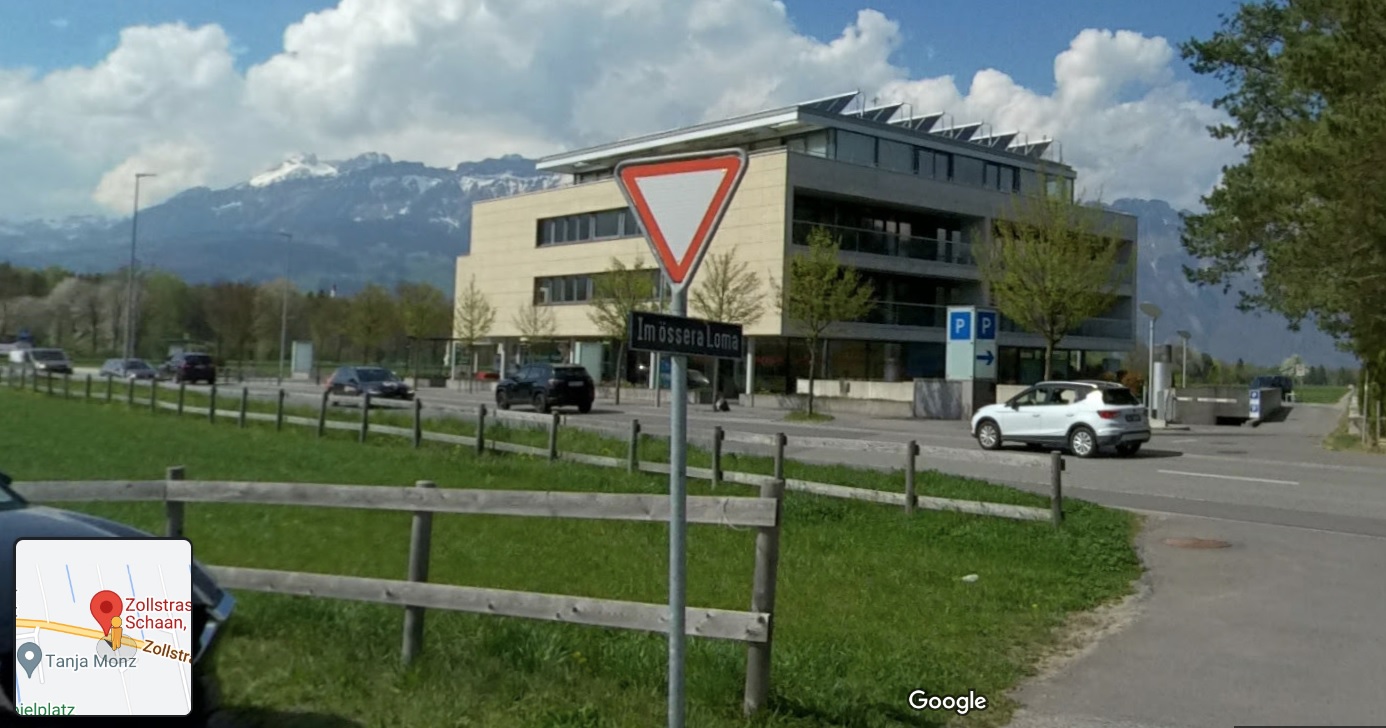 Your Vales Point power now in safe hands here at Zollstr 82, Schaan.
Your Vales Point power now in safe hands here at Zollstr 82, Schaan.
At least the office building has PV panels on the roof. The traffic sign says “Give Way”
From Delta’s “2022.09.16 Media Release Sale of Delta Group_FINAL.pdf”:
“On 16 September 2022 the owners of Delta Electricity (including Sunset Power International t/a Delta Electricity and Great Southern Energy t/a Delta Coal) agreed to a 100% share sale to Sev.en Global Investments (Sev.en), a family office investment group from the Czech Republic with a core focus on the Energy and Mining sectors.”
https://www.de.com.au/media/media-release-change-of-ownership
Under “Who we are” and “structure” we find Sev.en Global Investments a.s. which is 100% owned by 7 Global Investments Anstalt, in turn owned by 7 International Anstalt, both registered in Liechtenstein. Sole beneficiary is the controversial Prague based investor Pavel Tyzak who started to make his fortune by cleverly benefitting from a similar privatization wave in the Czech Republic beginning in the 1990s and leading to many ownership changes ever since.
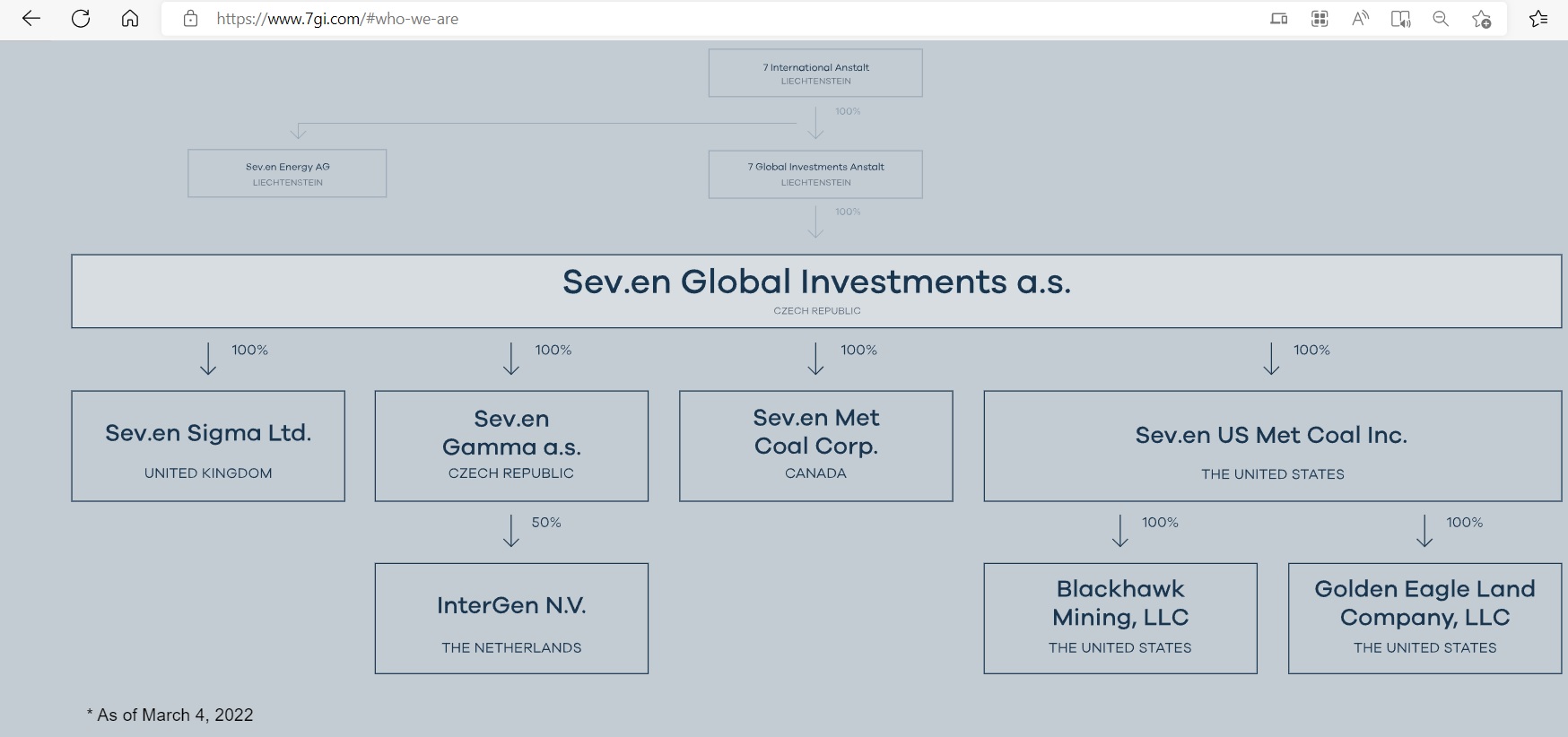 Sev.en Global Investments company and ownership structure
Sev.en Global Investments company and ownership structure
https://www.7gi.com/#structure
“Anstalt” (institution, establishment) is defined in Liechtenstein law.
World Bank: Guide to Beneficial Ownership Information in Liechtenstein:
Legal Entities and Legal Arrangements (updated 2018)
Anstalt (Establishment)
This corporate form with legal personality appears to be unique to Liechtenstein. It has no members or shareholders and is generally used as legal entity for a business enterprise or a holding company for intangible assets or for estate assets.
It can be an autonomous fund with beneficiaries. An Anstalt must have a minimum capital of CHF 30’000.00, EUR 30’000.00 or USD 30’000.00. The capital of this entity need not be divided into shares. An Anstalt can engage in both commercial and non-commercial activities.
An Anstalt can be set up by one or more founders, which may be individual person(s), a firm, a community or by an association of communes or a legal entity not otherwise entered in the Commercial Register. One or more founders must sign the written articles of establishment for its formation. Written articles are required for the formation of the Anstalt.
https://star.worldbank.org/sites/star/files/liechtenstein_bo_guide_-_updated_sept_2018_-_final.pdf
AG stands for “Aktien Gesellschaft” (in German, meaning share company) and a.s. for Akciová společnost (Czech) or Société Anonyme (in French) or Sociedad Anónima (in Spanish)
https://en.wikipedia.org/wiki/Aktiengesellschaft
Using Liechtenstein’s Commercial Register
https://www.oera.li/cr-portal/suche/suche.xhtml
by entering “7 International Anstalt” and “7 International Investments Anstalt” we find as address Zollstr. 82, Schaan.
On the 7gi website we also find what the main activities of the sister group of 7 Global Investments, 7 Energy are:
Mining
In Mining, Sev.en Energy operates the biggest lignite deposit in Czech Republic – the ČSA mine, and the Vršany mine, with the longest life of lignite deposits within the existing territorial limits, total production of 10.1m tons mined in 2021 and 2 090 employees. In 2021, the group invested EUR 10.7m towards land reclamation and recultivation.
Electricity And Heat Production
In Power Generation, Sev.en Energy operates mostly lignite fired power plants with installed capacity of 4×205 MW at Elektrárna Chvaletice, 5×205 MW at Elektrárna Počerady and 6 production blocks in Teplárna Kladno & Zlin with the output of c. 600 MWe and 1,300 MWth. In 2021, the group sold 9,400 GWh of produced electricity and over 2 000 TJ of produced heat (without Počerady)
https://www.7gi.com/
Let’s have a look:
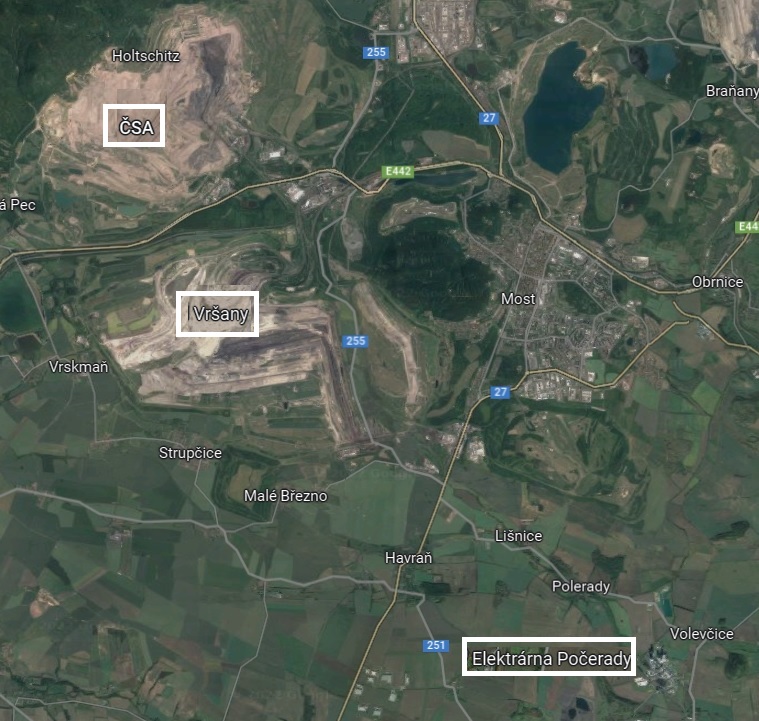 2 huge lignite mines in northern Bohemia. 7 kms south the Pocerady coal power plant.
2 huge lignite mines in northern Bohemia. 7 kms south the Pocerady coal power plant.
CSA within its current mining limits is basically depleted, causing enormous rehabilitation costs labelled as “investments” above. More on that in another post
FIRB board
The FIRB board has been staffed by the previous government.
https://firb.gov.au/about-firb
We find there the climate change denier veteran Nick Minchin – Resource and Finance Minister (1998-2007) under the energy and climate agnostic Howard government.
Will the FIRB check how Sev.en’s coal business is going to
• interfere on the NSW coal market as the economic coal supply from mature mines around Vales Point will be shrinking in future?
• integrate into current Australian plans (NSW electricity plan, AEMO’s ISP) to get away from coal?
Let’s explore Sev.en’s objectives in a very interesting interview Angela Macdonald Smith from the AFR had with Alan Svoboda (now also available here: https://www.7gi.com/media/2022/20220918a.html)
We sum up what Alan said:
(1) Energy transition will be taking longer and is more complicated “than visionaries portray”
(2) Investments in coal will continue as long as they are needed for “reasonable backup” throughout the transition and potentially be phased out. New technologies like batteries or solar power can benefit from the location of coal assets Sev.en will continue with proposals for a large solar power plant at the Vales Point site.
(3) “We are hungry to broaden our investment base in Australia; we find the country extremely investor-friendly and transparent, and supporting the type of industries that we believe we can be really successful in”
(4) As banks and other institutional investors are reluctant Sev.en can invest in the long term and help the coal business by using its own equity. It would not be for the purpose of making quick money and exit again.
(5) Rules and regulations imposed by Australia on coal assets will be respected.
(6) A separation from China’s Huaneng Group at InterGen in Queensland is considered with an ownership of either Milmerran or Callide C power plants so that Vales Point can be part of an “interesting base of power generation” on the east coast.
We first need to understand some basics.
Vales Point power generation
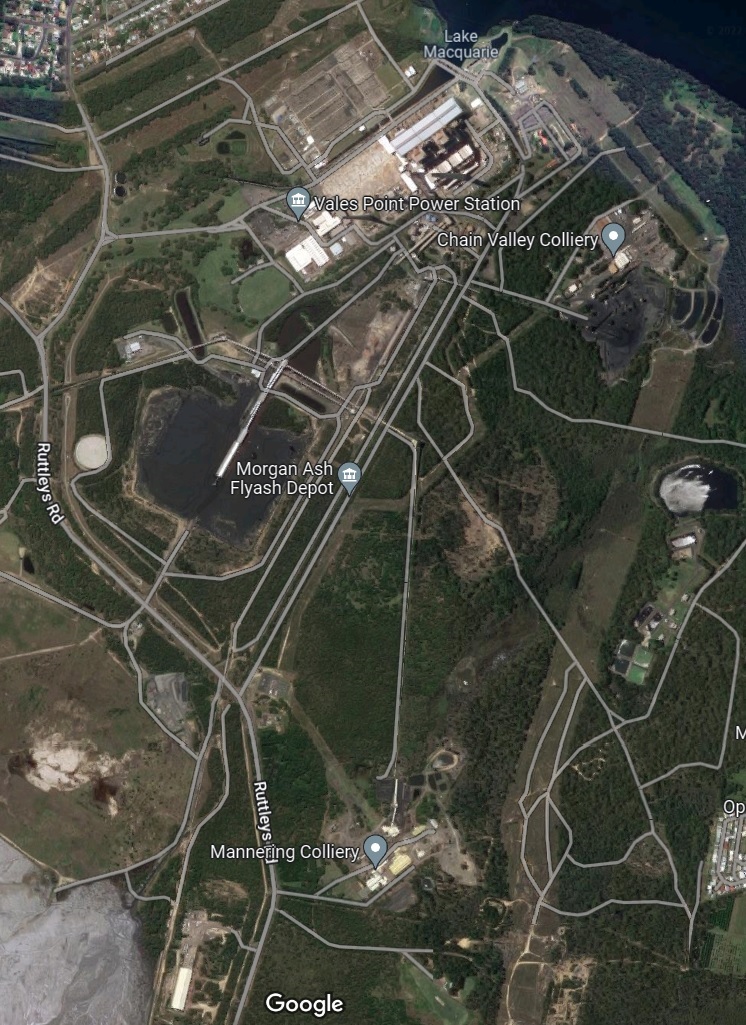
Monthly output of Vales Point B (built in 1978, VP A decommissioned in 1989) has been very variable over more than 2 decades:
 https://opennem.org.au/facility/au/NEM/VP/?range=all&interval=1M
https://opennem.org.au/facility/au/NEM/VP/?range=all&interval=1M
In fact, as Delta announced its sale on 16 Sep 2022, Vales Point was running at only 41% of the practically achievable daily maximum of 28.6 GWh later in the month.
 For half of the last 30 day period, Vales Point used only VP5.
For half of the last 30 day period, Vales Point used only VP5.
Registered capacity/max actual output of VP5: 660/630 MW; VP6: 660/645 MW. Here is already a very big difference to Pavel Tykac’s Czech power plants which come in much smaller 200 MW units. So when there is maintenance in Pocerady, for example, one unit is only 25% of output, in Chvaletice only 20%. But Pavel should know this. After all he specializes in bargains of old, unreliable power plants.
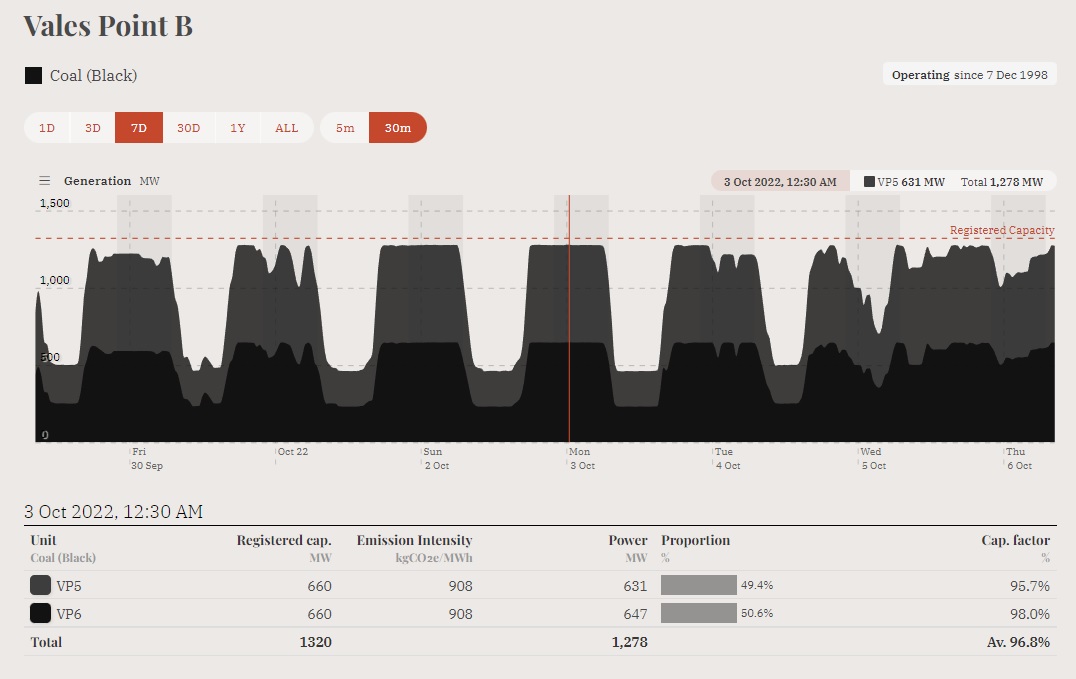 The daily variability is given by lower grid demand during daytime (use of solar energy)
The daily variability is given by lower grid demand during daytime (use of solar energy)
https://opennem.org.au/facility/au/NEM/VP/?range=7d&interval=30m
The baseload component in this period is around 500 MW. Let’s assume the phased shut down of the 630 MW unit. Then the overnight generation above 645 MW would be 635 MW over 12 hrs = 7,620 MWh. Just for comparison one Tumut 3 pumped hydro (out of 6) has 300 MW. The Wallerawang battery has 500 MW over 2 hrs, so 8 batteries would be needed, each discharging slowly.
Surely Pavel has better plans?
Coal supplies for Vales Point
Another challenge is coal supplies. The area around Vales Point power plant including beautiful Lake Macquarie is perforated, punctured and pierced by numerous underground coal mines on 3 stacked seam levels (Wallarah, Great Northern and Fassifern)
Mannering Colliery
This mine started off in 1960 as the Wyee State Colliery for Vales Point A. There is a chequered history with many changes in ownership – some due to cases of administration, interruptions in production, subsidence and other environmental problems.
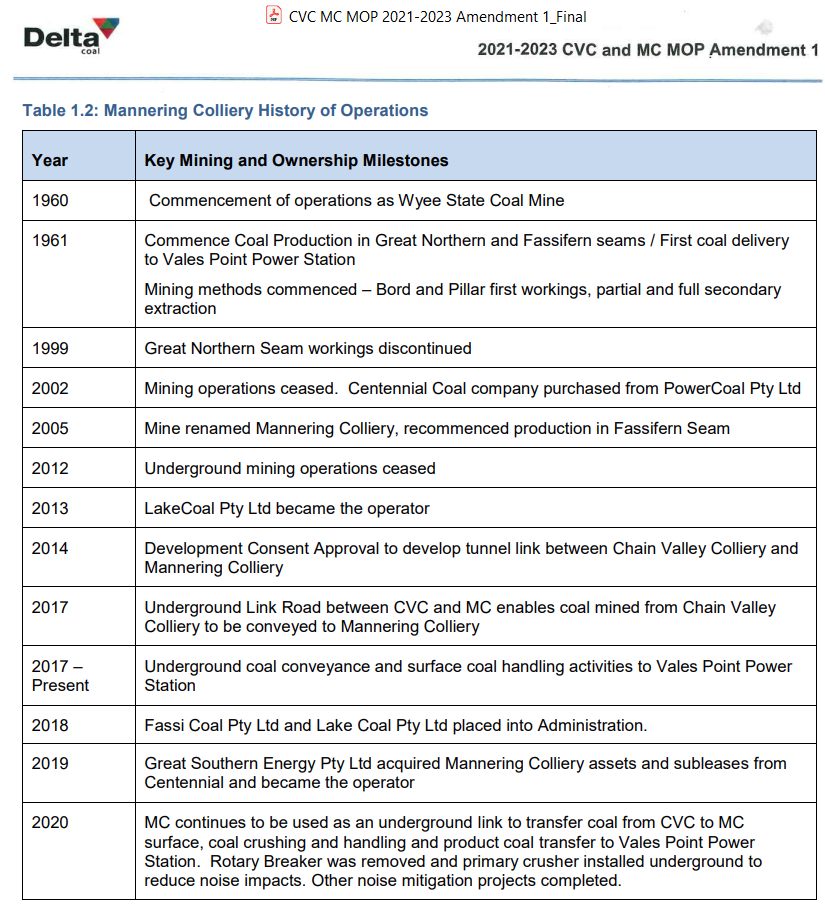
From Lake Coal’s 2016 Annual Review:
The Fassifern seam is 150 – 205 m deep with a thickness of 3 m out of which 1-1.2 m are inferior coal left on the roof. The depth of the Great Northern seam is 140-155 m with a typical thickness of 2.5 m. Both seams have a low sulphur content.

The following overview is from Lake Coal’s 2017 Annual Review. Underground mining had proceeded into areas under Lake Macquarie, where north east of Mannering Park a lake floor subsidence of 780 mm is allowed.
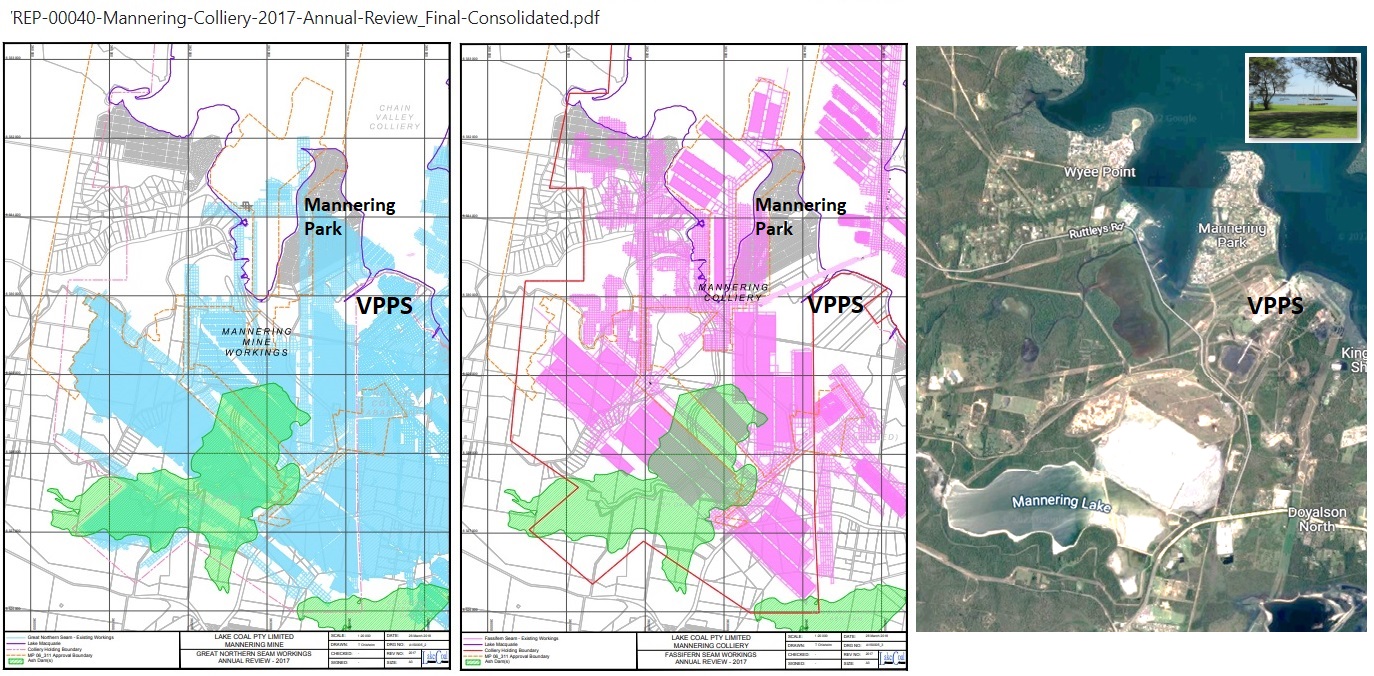 Left panel: blue areas Great Northern seam. Centre panel: pink areas: Fassifern seam. Right panel: Google map with insert of Lake Macquarie from Mannering Park looking east. Green areas (misleading color!) are ash dams.
Left panel: blue areas Great Northern seam. Centre panel: pink areas: Fassifern seam. Right panel: Google map with insert of Lake Macquarie from Mannering Park looking east. Green areas (misleading color!) are ash dams.
https://www.deltacoal.com.au/environment/mannering-colliery/mannering-colliery-annual-and-audit-reporting
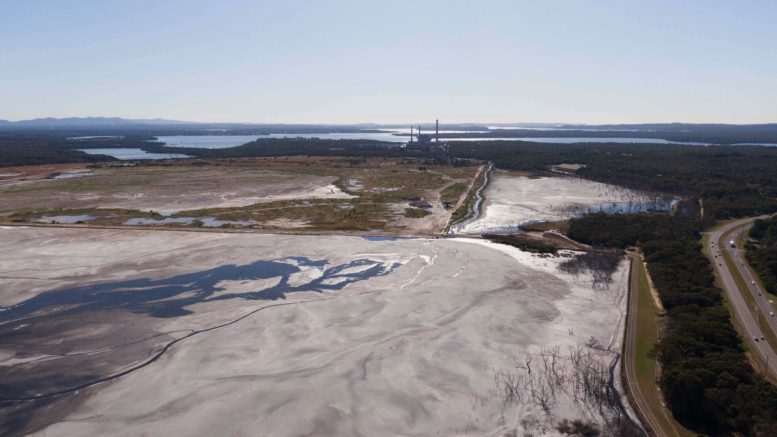 View over the Mannering ash dam with Vales Point in the background. Rehabilitation job for Pavel
View over the Mannering ash dam with Vales Point in the background. Rehabilitation job for Pavel
https://coastcommunitynews.com.au/central-coast/news/2020/10/at-least-60-million-tons-of-coal-ash-needs-to-be-removed/
LEGISLATIVE COUNCIL PUBLIC WORKS COMMITTEE
Costs for remediation of sites containing coal ash repositories
March 2021
• Vales Point generates about 0.7Mt of ash waste a year, 0.18Mt is reused.
• there are six legacy asbestos dumps identified where that coal ash cannot be disturbed
• Upon closure of Vales Point power station, the NSW Government has granted Delta [which bought Vales Point in 2015] a put option to transfer Vales Point power station back to the NSW Government after decommissioning obligations have been met. There are no specific de-commissioning obligations pertaining to the ash dam aside from maintaining site security and depowering the site. If Delta does not exercise the put option, the NSW Government has a call option allowing it to transfer Vales Point back to the NSW Government.
https://www.parliament.nsw.gov.au/committees/inquiries/Pages/inquiry-details.aspx?pk=2556
Delta electricity argued in that inquiry that progressive capping of the ash dam is paid for by a fee charged to companies who deposit excavation material on the ash. Monitoring cost will be covered by lease fees for a solar farm on rehabilitated ponds. Remediation requirements at plant closure will depend upon the amount of recycling over time and the final level of the ash dam. If the put and call option is used by either party, it is possible the NSW government will be responsible for capping and rehabilitating the remaining areas of ash. Before the sale, a pre-existing contamination assessment was done by ERM between Feb and Jul 2014. These assessments are also available here:
https://www.treasury.nsw.gov.au/information-public-entities/government-businesses/post-transaction-management/environmental-baseline-studies
Legal battles over who pays what are already pre-programmed.
The committee also noted that the Baird/Berejiklian government had argued that it would avoid $2 billion of liabilities when privatizing 4 coal fired power plants.
Media release 19 Nov 2015
“Ms Berejiklian said these divestments have generated $870 million for Restart NSW
and terminated $1.2 billion of debt and $2 billion of future liabilities.”
https://www.treasury.nsw.gov.au/sites/default/files/mediarelease/20151119–media-Berejiklian—Gentrader-deal-cleaned-up–Vales-Point-and-Cobbora.pdf
That would be $300 m (15%) for Vales Point.
According to Delta Coal’s Annual Review 2021 published in Mar 2022
https://www.deltacoal.com.au/environment/mannering-colliery/mannering-colliery-annual-and-audit-reporting
• ROM coal produced in 2021 was 0 (zero) tons
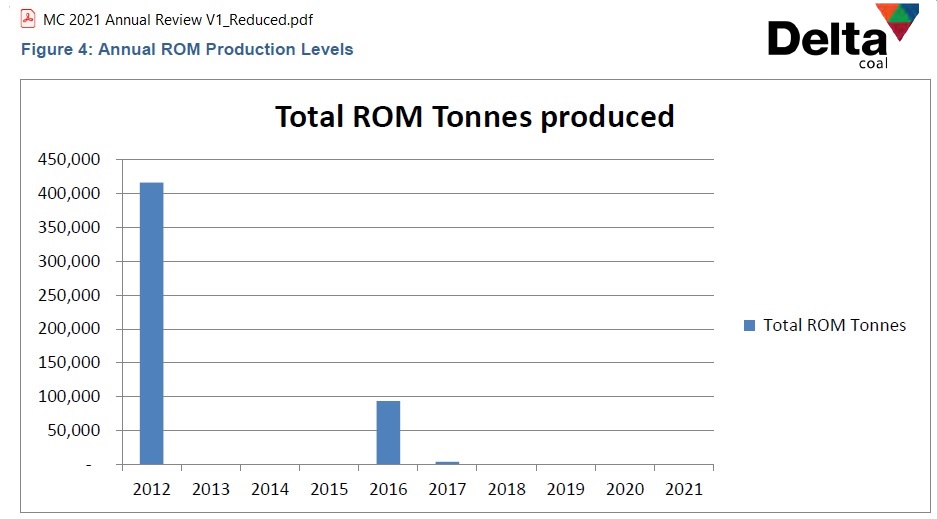 Mannering colliery stopped producing coal in 2013. The 2016 production is from the underground link road project (Mod 2) to the Chain Valley Colliery (Lake Coal)
Mannering colliery stopped producing coal in 2013. The 2016 production is from the underground link road project (Mod 2) to the Chain Valley Colliery (Lake Coal)
• Product coal transferred from the Chain Valley Colliery (CVC) to Vales Point Power Station (VPPS) was 1.247 mt in 2021.
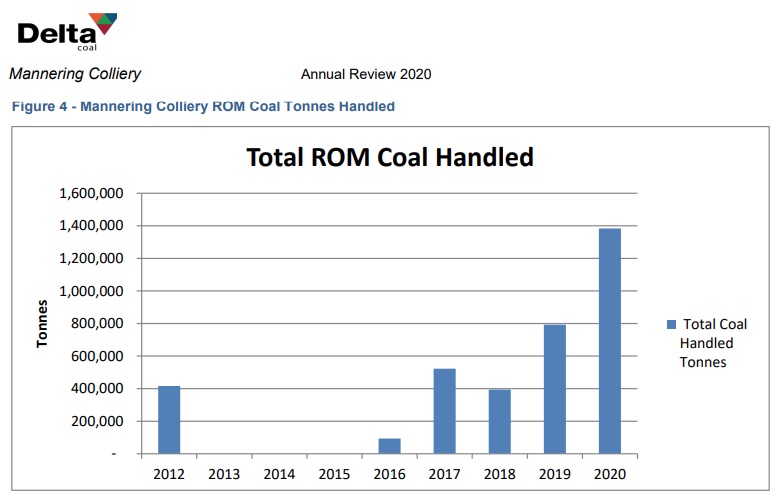 Transfer from CVC instead of production
Transfer from CVC instead of production
• Modification 5 of MP06_0311 allows an extension of ROM coal production (alternate bord and pillar mine design) up to 1.1 Mtpa until Dec 2027 and permits 2.1 mtpa of ROM coal handling for the transfer of coal from CVC to VPPS in accordance with CVCs approved extraction limit. All coal from MC is transported via a drift conveyor system to the surface and dedicated overland conveyor to VPPS for domestic energy generation.
https://www.deltacoal.com.au/ArticleDocuments/10465/MC%202021%20Annual%20Review%20V1_Reduced.pdf.aspx
To be continued
Summary so far
In 2015 the NSW government moved all the problems of its Vales Point power plant and associated coal mining to a domestic private investor. 7 years later, the same problems are set to be forwarded to an international company which expects to make money with a growing coal business. We are only one mining accident and one turbine failure/boiler explosion away from this export model to fail. Has Callide C not been a lesson?